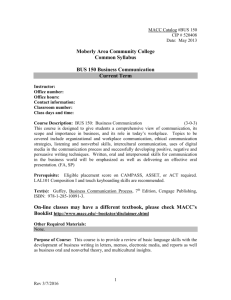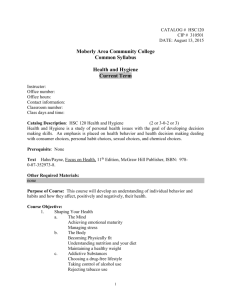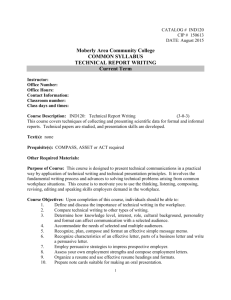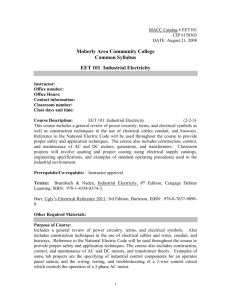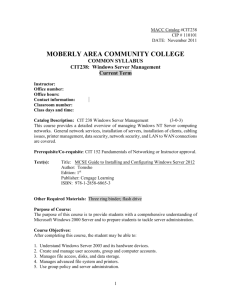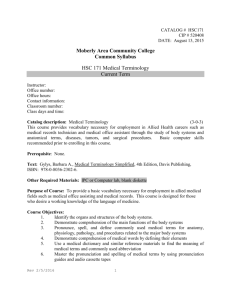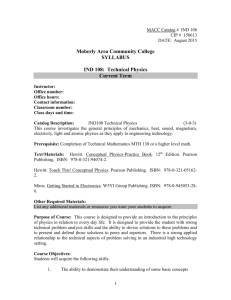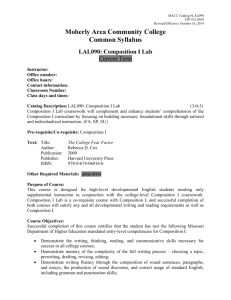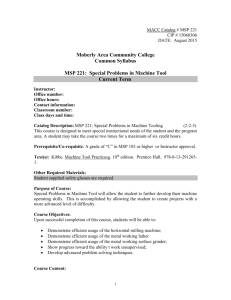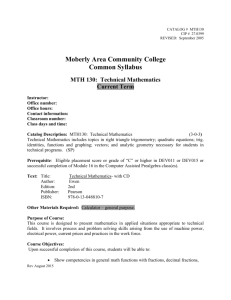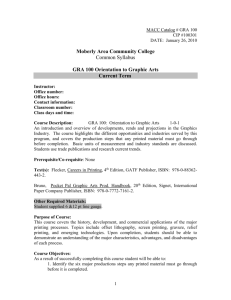DDT 227 Architectural Design III
advertisement
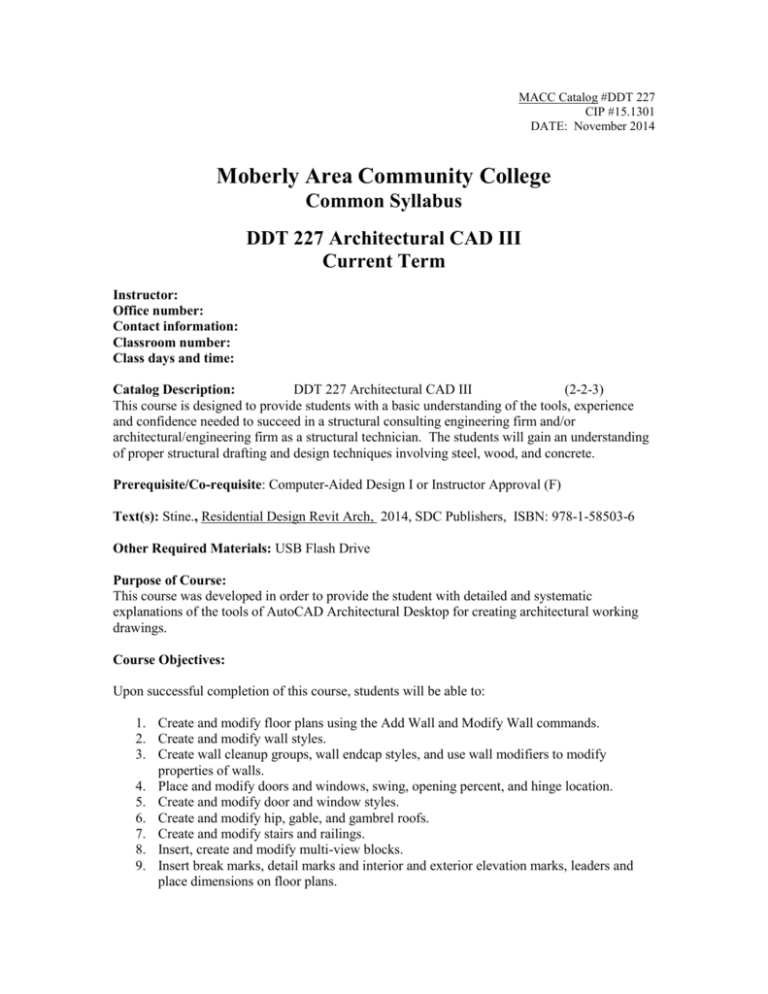
MACC Catalog #DDT 227 CIP #15.1301 DATE: November 2014 Moberly Area Community College Common Syllabus DDT 227 Architectural CAD III Current Term Instructor: Office number: Contact information: Classroom number: Class days and time: Catalog Description: DDT 227 Architectural CAD III (2-2-3) This course is designed to provide students with a basic understanding of the tools, experience and confidence needed to succeed in a structural consulting engineering firm and/or architectural/engineering firm as a structural technician. The students will gain an understanding of proper structural drafting and design techniques involving steel, wood, and concrete. Prerequisite/Co-requisite: Computer-Aided Design I or Instructor Approval (F) Text(s): Stine., Residential Design Revit Arch, 2014, SDC Publishers, ISBN: 978-1-58503-6 Other Required Materials: USB Flash Drive Purpose of Course: This course was developed in order to provide the student with detailed and systematic explanations of the tools of AutoCAD Architectural Desktop for creating architectural working drawings. Course Objectives: Upon successful completion of this course, students will be able to: 1. Create and modify floor plans using the Add Wall and Modify Wall commands. 2. Create and modify wall styles. 3. Create wall cleanup groups, wall endcap styles, and use wall modifiers to modify properties of walls. 4. Place and modify doors and windows, swing, opening percent, and hinge location. 5. Create and modify door and window styles. 6. Create and modify hip, gable, and gambrel roofs. 7. Create and modify stairs and railings. 8. Insert, create and modify multi-view blocks. 9. Insert break marks, detail marks and interior and exterior elevation marks, leaders and place dimensions on floor plans. 10. 11. 12. 13. 14. 15. 16. 17. 18. Place fire rating lines on walls. Create match lines, north arrows, datum elevations, and revision clouds. Create and modify elevations and sections. Create and modify mass elements. Create, modify, extrude and revolve an AEC Profile. Create and modify mass groups. Create floorplate Slices. Move mass elements to create a model. Create and modify spaces and boundaries. Course Content: Chapter 1: Introduction to Architectural Chapter 2: Creating Floor Plans Chapter 3: Advanced Wall Features Chapter 4: Space Planning and Mass Modeling Chapter 5: Placing Doors and Windows Chapter 6: Door/Window Assemblies and Curtain Walls Chapter 7: Creating Roofs and Roof Slabs Chapter 8: Creating Slabs for Floors and Ceilings Chapter 9: Stairs and Railings Chapter 10: Using and Creating Symbols Chapter 11: Annotating and Documenting the Drawing Chapter 12: Creating Elevations, Sections, and Details Assessment of Student Learning: Students are assessed on their active participation in class projects and discussions as a team along with their ability to work as an individual. Role will be taken during each class session and student will receive the appropriate grade for participation in group assignments and projects as well as individual work. Midterm Overall class project Cumulative final exam 20% 50% 20% 200 points 600 points 200 points Description of Major Assignment(s)/Project(s): Students will be required to complete review questions at the end of each chapter, the review will be gone over together in class. The students will also be required to complete assigned tutorials from each chapter and complete a final project. Program Assessment The Drafting Design Technology faculty, continually strive to meet the needs of their students through program improvements. These improvements are a result of program assessments and the consultation and advisement of the DDT Advisory Committee. In addition to the course assessments outlined in this syllabus, the objectives achieved in this course will also be an integral part of the Drafting Design Technology program assessment. Students will be assessed on the mastery of course concepts and essential skills attained in this course at the end of the program. Instructor Policies: Academic Dishonesty: MACC board policy is as follows: “Academic dishonesty by students damages institutional credibility and unfairly jeopardizes honest students; therefore, it will not be tolerated in any form.” Forms of academic dishonesty include but are not limited to the following: violations of copyright law, plagiarism, fabrication, cheating, collusion, and other academic misconduct. Incidents of dishonesty regarding assignments, examinations, classroom/laboratory activities, and/or the submission of misleading or false information to the College will be treated seriously. The procedure for handling academic dishonesty is outlined in the Student Handbook (Policy Handbook M.010). In cases of alleged academic dishonesty, the burden of proof is on the student, not on the instructor. Attendance: Any student who misses two consecutive weeks of class during a regular sixteen-week semester or the equivalent proportion of class time during a shorter session will be dropped from the class by the instructor unless acceptable justification is supplied. Additionally, any student who misses more than one-fourth of the entire number of in-seat class meetings in a regular 16-week semester or the equivalent proportion of class time during a shorter session, may be dropped from that class by the instructor if, in the opinion of the instructor, the student does not have reasonable opportunity to succeed in the class. A student’s attendance rate will be calculated based upon the first day of the semester (not the student’s date of enrollment in the course). Student attendance must be defined in a different manner for online, hybrid, and virtual courses. Student attendance in these courses is defined as active participation in the course. Online, hybrid, and virtual courses will, at a minimum, have weekly mechanisms for student participation, such as any or all of the following methods: a. Completion of quizzes or exams b. Submission of assignments c. Participation in threaded discussions d. Communication with the instructor A student who does not participate in an online, hybrid, or virtual course for two consecutive weeks will be dropped by the instructor unless acceptable justification is supplied. As with ground courses, a student’s attendance rate in online courses will also be calculated based upon the first day of the semester. If a student does not demonstrate active participation in the online course within the first two weeks (or the equivalent proportion of class time during a short session), the student will be dropped as “never attended.” Simply logging into an online class does not constitute active participation. Students should be aware that their dropping a course and their last date of attendance in the course may impact their financial aid. Tardiness: Three tardies will count as one absence. If you must arrive after class begins, please be courteous of other students by entering quietly and taking the seat nearest the door. Any daily quizzes that occur during your absence or if you are tardy will not be able to be taken at a later date. Make-up and late work: Any daily quizzes that occur during your absence or if you are tardy will not be able to be taken at a later date. Late work must be handed in during the next class session. Extra-credit work: Student is allowed extra credit, up to 20 points but not exceeding 20 points. College Policies/Procedures: ADA Statement Students who have disabilities that qualify under the Americans with Disabilities Act may register for assistance through the Office of Access and ADA Services. Students are invited to contact the Access Office to confidentially discuss disability information, academic accommodations, appropriate documentation and procedures. For more information, please call either the Moberly office at (660) 263-4100 x 11240 or the Columbia office at (573) 234-1067 x 12120, or visit our web page at http://www.macc.edu/index.php/services/access-office.
